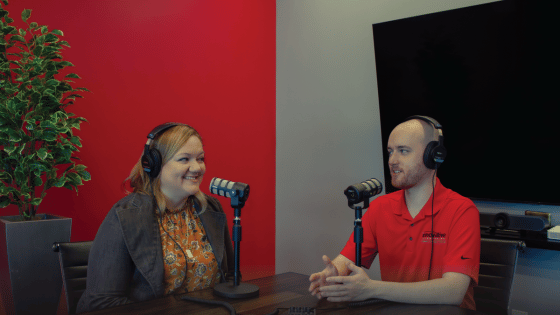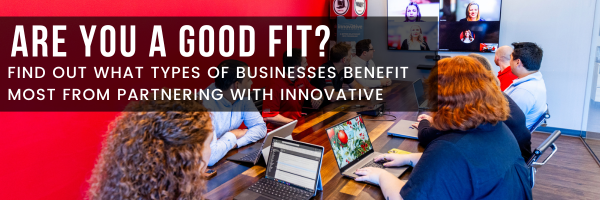EOS from an Employee's Perspective
So, the company you're speaking to or working with has mentioned EOS (Entrepreneurial Operating System), but what is EOS, and why should it be on your radar?
EOS is defined as “a people operating system that harnesses human energy through a simple set of tools and principles.” As described in "What the Heck is EOS?" by Gino Wickman and Tom Bouwer, over 50,000 companies worldwide rely on EOS, particularly those with 10 to 250 employees who are focused on growth.
The EOS model has Six Key Components that businesses should focus on and strengthen: vision, people, data, issues, process, and Traction. This article will focus on how some of these components are addressed through different functions of EOS, specifically through the lens of an employee (me!).
At Innovative, we've embraced EOS for over a couple of years, firmly believing in its advantages for us and our clients. As an Innovative employee for the better part of those years, I’ve certainly felt its impact firsthand. Let’s take a look at EOS!
Vision and Traction
In any business, chaos and confusion are the last things you want. EOS helps avoid disarray by providing the framework to establish both long-term and short-term goals for your business, translating them into actionable tasks, and ensuring accountability for their completion. This standardized approach brings focus and direction to the company's efforts.
As an Innovative employee, the Vision/Traction Organizer (V/TO) has been a game-changer. It provides a clear snapshot of our company's direction, goals and strategies. Understanding where we're headed and how we plan to get there is motivating. It reinforces the purpose behind my work and acts as my guide.
Our core values, Core Focus and Core Target are all laid out there for everyone to see, in addition to our one-, three- and ten-year targets. There are no secrets when it comes to how we operate. Our three-year plan can be felt in our one-year plan, and our one-year plan can be felt in our quarterly Rocks. The V/TO illustrates a clear direction for the business. And speaking of Rocks, let me explain what those are!
Rocks
Rocks are 90-day objectives for which employees are accountable. They represent the top priorities that align closely with the company's overarching goals. By breaking these goals or tasks into 90-day chunks, employees can focus on the task at hand and then regroup after 90 days, rather than setting yearly goals and lacking focus as the year progresses.
As an employee, Rocks help me prioritize and plan. They keep me focused on the most important tasks for my department and the company as a whole while still allowing the rest of my daily tasks to fill in my schedule around them.
An example of one of my Rocks was to start creating regular video content for our social media pages. Sure, this could have been thrown on my to-do list, but setting it as a Rock held me accountable for completing it within 90 days, as I felt it was a vital component to help boost our social media presence.
Level 10 Meetings
Weekly departmental meetings provide a rhythm and focus to each week at Innovative. The rhythms within those meetings, called Level 10 meetings, allow our team to stay in the loop on day-to-day news and issues while providing a forum to present new issues or problems and identify and solve them.
These meetings are collaborative and help ensure each team member has the opportunity to seek assistance when needed so they can do their job. For example, suppose there are some communication issues within the company or between departments, but a team member can’t find the root cause. In that case, they can bring it to the Level 10 meeting to IDS it: Identify, discuss, solve.
From there, the team can discuss a proper solution to the teammate’s issue, or one of the managers present in the meeting can escalate the problem to another meeting or to leadership. While each department’s meeting happens separately, everyone in the company can point to their Level 10 as the go-to place to discuss and solve their issues.
I’ve found the Level 10 format extremely helpful in structuring our meetings and prioritizing the agenda. Rather than randomly going down the issues list, we pick the top three issues, rinse, and then repeat. It makes better use of our time and leads to more meaningful discussion than discussing topics just in the order they were listed.
People & Processes
A fundamental aspect of EOS revolves around people management. It's crucial to have the right people in the right seats. EOS emphasizes hiring based on cultural fit and attitude, not just technical qualifications. Businesses can build a cohesive and motivated workforce by prioritizing alignment with core values and company culture.
This philosophy can absolutely be felt as an employee. No matter the position or department, the feeling of people being bought in is tangible. Our core values are something that can be felt. They aren’t just words plastered on a wall or a poster. I believe “right person, right seat” is invaluable to a company.
EOS also encourages the documentation of core processes that define a company's unique identity. These are not routine daily tasks but rather the specialized procedures that set a company apart. Some might call it “the secret sauce.” By establishing a framework for documenting and following these processes, EOS ensures consistency and reliability in what your company does best.
The documentation of our core processes has been fun to watch and a point of pride as it represents our awesome work (though I am a little biased!).
We Even Started a Podcast!
Our belief in EOS even inspired us to start a podcast! “Innovative Leadership” gives us the opportunity to sit down and have business and people conversations with business leaders and entrepreneurs. EOS is a frequent topic, and several of our guests have implemented EOS in their own businesses. In fact, the creation of this podcast started as a Rock!
Why It Matters to Your Business
EOS (when properly implemented) brings transparency and predictability to a company's operations, reducing uncertainty for its customers or clients. As an employee, it’s comforting to know that the company's hiring, problem-solving and processes are aligned with its vision.




